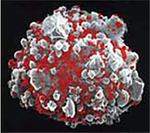Consisting of an HIV strain, inactivated by three orthogonal methods: a genetic method to attenuate the virus, a physical method called CFI and a chemical method called AT-2
HIV/AIDS – Attacking the Immune System Challenges Vaccine Development
 There are 33 million AIDS cases worldwide, with over 95% of them in the developing world. There is currently no vaccine against HIV: and AIDS, if untreated, will lead to the death of more than 95% of infected individuals 10 years post-infection. The only major positive development in the field has been a recent formulation of triple-drug therapy, in which patients receive a combination of three different drugs targeting two viral proteins. However, while highly successful in many cases, triple-drug therapy is not without caveats related to quality of life, cost, toxicities, and resistance.
There are 33 million AIDS cases worldwide, with over 95% of them in the developing world. There is currently no vaccine against HIV: and AIDS, if untreated, will lead to the death of more than 95% of infected individuals 10 years post-infection. The only major positive development in the field has been a recent formulation of triple-drug therapy, in which patients receive a combination of three different drugs targeting two viral proteins. However, while highly successful in many cases, triple-drug therapy is not without caveats related to quality of life, cost, toxicities, and resistance.
The development of a vaccine against the infectious agent that attacks the immune system has proven to be extremely challenging. There are many reasons for this, the main one being the ingenious way HIV replicates and persists in the infected host.
Vaccine Development Challenged by HIV Genetic Diversity and Antigenic Drift
The enormous genetic diversity of HIV presents a major problem for vaccine development. Not only are there numerous viral genotypes, with new ones likely to emerge, but there is also the capability for permanent genetic and antigenic drift, which enables the virus to evade the host immune response (IR) in a single infected person.
HIV diversity and capability for antigenic drift are only two of the reasons for the inefficiency of first-generation anti-HIV vaccines, which induced a humoral (antibody) response against a limited number of epitopes. Those vaccines included whole inactivated virus preparations, utilizing heat or formalin, or a recombinant envelope protein of HIV gp120.
HIV/AIDS Therapeutic Vaccine with Annual Boosts
The gravity of the epidemiological situation will make any efficient therapeutic vaccine a highly attractive product, even if it may require an annual boost for maintenance of protection; based on contemporary scientific data, such a scenario is likely. The necessary vaccine strategy for HIV may, therefore, resemble the situation that currently exists with influenza vaccination, where annual shots that target the predominant viral strain, which differs from year to year, are needed.
An inactivated attenuated HIV vaccine preparation, which retains the conformation of envelope proteins, may become a valuable component of such a vaccination regimen.
HIV/AIDS Therapeutic Vaccine
- Our therapeutic HIV/AIDS vaccine consists of an inactivated a strain of HIV, inactivated by three orthogonal methods: a genetic method to attenuate the virus, a physical method called CFI and a chemical method called AT-2.
- These methods inactivate HIV without causing major structural and physical damage to the virion, including gp120. Such a vaccine preparation should induce both humoral and cellular immune responses. We expect the inactivated attenuated virion to behave similarly to live HIV, with the exception of integration and replication.
- Thus, the inactivated attenuated virion will bind to and be taken up by dendritic cells and macrophages, which will then present antigens to CD4+ and CD8+ T cells for the generation of T cell help and cytotoxic T cells.
- Previous experiments in chimpanzees showed that good humoral and cellular responses could be induced with an inactivated, whole HIV immunogen. A more recent study showed induction of humoral and cellular responses with virus-like particles. Finally, both humoral and cellular responses were generated after immunization with AT-2 inactivated SIV.